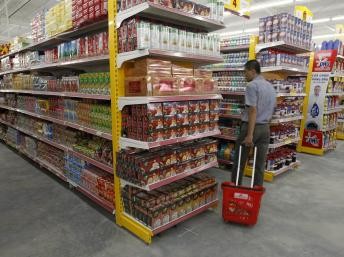 |
| Vietnam’s economic growth in the first half of this year is lower than the same period last year. The photo is taken at Fivimart, Hanoi on June 15th, 2012. (REUTERS/Kham) |
(VOVworld) – Despite many difficulties, Vietnam’s economy was on the right track in the first half of this year and has enjoyed several positive changes. According to the Prime Minister’s assessment, the Government’s measures to control inflation and the macro-economy are taking effect. VOV reporter To Tuan reviews the country’s economic performance so far this year.
Although the gross domestic product was low at 4.38% in the first half of 2012, it remains higher than the Government’s estimate, according to the General Statistics Office. The fall in GDP is attributed to high inflation and interest rates, shrinking production, continuous natural disasters and the impacts of the global financial slowdown and the debt crisis in the prolonged euro zone. However, since the second quarter, Vietnam’s economy has showed many positive signs, especially in industrial output and construction. The country attracted 452 FDI projects, with a total value of 4.76 billion USD and earned over 53 billion dollars from exports. The consumer price index, CPI has seen a successive decrease, with a slight fall of 0.26% in June. Do Thuc, Director of the General Statistics Office, says ‘The global economic recession means a consecutive decline over many months. However, in the past, inflation was always high, but it dropped a bit in the first 6 months of this year. This is a positive change for the national economy. What we should do now is to keep price rises at an appropriate rate to ensure economic stability’.
The top priority for economic management in the near future is to continue with the Government’s resolution on measures to tackle obstacles to production and business to support the market. The most pressing issue is to deal with the current huge stockpiles of foods and commodities. In addition, the State Bank of Vietnam will outline possible solutions for dropping the interest rate, and implementing monetary policies flexibly, to ensure that the level of loans can be raised, but tightly controlled for the remainder of the year. Prime Minister Nguyen Tan Dung comments on the socio-economic situation in the reviewed period ‘I asked ministers to give a quick account of the restructuring of state-owned enterprises, especially the scale and re-arrangement of businesses, and their products forcing them to focus only on core business. SOEs need to overhaul their management and strengthen their business to ensure efficiency. In addition, the Government will clarify the decentralizing of the powers and responsibilities of the owner of SOEs’.
Dung said that the Government has been determined to stick to its targets on macro-economic stability and the inflation rate to achieve 14 out of 15 criteria set for this year. To realize this, the Government will focus on 6 groups of solutions. They include to continue with tight monetary policies, carefully combine monetary and fiscal policies, stabilize the exchange rate and manage the interest rate. They will also continue with measures to support agriculture and certain industries and services. From now until the year’s end, the inflation rate is expected to reach 8%, and GDP should lie between 5.2 and 5.7%.